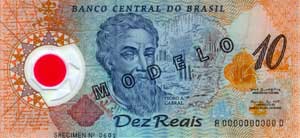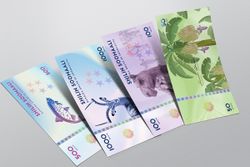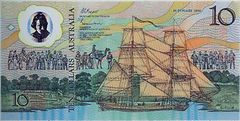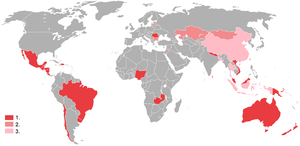النقود البلاستيكية
النقود البلاستيكية Polymer banknotes هي أوراق نقدية مصنوعة من پوليمر مثل متعدد الپروپلين الموجـَّه على محورين (BOPP). نقود كتلك تضم العديد من سمات الأمان غير المتوفرة في النقد الورقي، بما في ذلك استخدام metameric inks.[1] النقود البلاستيكية تـُعمـِّر أطول كثيراً من النقود الورقية، causing a decrease in environmental impact and a reduced cost of production and replacement.[2]
Modern polymer banknotes were first developed by the بنك احتياط أستراليا (RBA) وCommonwealth Scientific and Industrial Research Organisation (CSIRO) و جامعة ملبورن. They were first issued as currency in Australia during 1988 (coinciding with Australia's bicentennial year). وفي 1996 Australia switched completely to polymer banknotes. Other countries that have switched completely to polymer banknotes include: بروناي وكندا ونيوزيلندا وپاپوا غينيا الجديدة وRomania و ڤيتنام. The latest countries to introduce polymer banknotes into general circulation include: المملكة المتحدة ونيجيريا والرأس الأخضر وتشيلى وگامبيا ونيكاراگوا وترنيداد وتوباگو والمكسيك, المالديڤ، موريتانيا، بوتسوانا، ساو تومي وپرنسيپي ومقدونيا وروسيا وأرمينيا وجزر سليمان ومنظمة دول شرق الكاريبي (OECS).
أصل التعبير
The use of the term "polymer" in place of "plastic" to describe banknotes was introduced on 1 November 1993 by the Reserve Bank of Australia, at the launch of its $10 note. Jeffrey Bentley-Johnston and his firm were retained to assist in the launch of the $10 note after the $5 note received a cool reception. Having earlier worked in a firm that designed and constructed synthetic fibre plants, Bentley-Johnston recognised the polymer nature of the new banknote and so proposed the use of that term.
التاريخ
In 1967 forgeries of the Australian $10 note were found in circulation[3] and the Reserve Bank of Australia was concerned about an increase in counterfeiting with the release of colour photocopiers that year. In 1968 the FGH started collaborations with RTASOC, and funds were made available in 1969 for the experimental production of distinctive papers. The insertion into banknotes of an optically variable device (OVD) created from diffraction gratings in plastic as a security device was proposed in 1972. The first patent arising from the development of polymer banknotes was filed in 1973. In 1974 the technique of lamination was used to combine materials; the all-plastic laminate eventually chosen was a clear, BOPP laminate, in which OVDs could be inserted without needing to punch holes.
An alternative polymer of polyethylene fibres, marketed as Tyvek by DuPont, was developed for use as currency by the American Bank Note Company in the early 1980s. Tyvek did not perform well in trials: smudging of ink and fragility were reported as problems. Only Costa Rica and Haiti issued Tyvek banknotes; test notes were produced for Ecuador, El Salvador, Honduras and Venezuela but never placed in circulation. Additionally, English printers Bradbury Wilkinson produced a version on Tyvek but marketed as Bradvek for the Isle of Man in 1983; however, they are no longer produced.
سمات أمنية

Polymer banknotes usually have three levels of security devices. Primary security devices are easily recognisable by consumers and may include intaglio, metal strips, and the clear areas of the banknote. Secondary security devices are detectable by a machine. Tertiary security devices may only be detectable by the issuing authority when a banknote is returned.[4]
اعتماد النقود البلاستيكية
Modern polymer banknotes were first developed by the Reserve Bank of Australia (RBA) and the Commonwealth Scientific and Industrial Research Organisation or CSIRO and first issued as currency in Australia during 1988, to coincide with Australia's bicentennial year.[5] Note Printing Australia (a wholly owned subsidiary of the RBA) prints regular and commemorative banknotes for circulation, and has done so for 20 countries. Trading as Innovia Security, Innovia Films markets BOPP as "Guardian" for countries with their own banknote printing facilities.
As of 2014, at least seven countries have converted fully to polymer banknotes: Australia, Brunei, Canada, New Zealand, Papua New Guinea, Romania and Vietnam. Other countries and regions with notes printed on Guardian polymer in circulation include: Bangladesh, Brazil, Chile, Costa Rica, Dominican Republic, Hong Kong (for a 2-year trial), Indonesia, Israel, Kuwait, Malaysia, Mexico, Nepal, Philippines (no longer issued), Solomon Islands (no longer issued), Samoa, Singapore, Sri Lanka, Thailand and Zambia. Canada released its first polymer banknote ($100) on 14 November 2011, followed by the $50 banknote on 26 March 2012, the $20 banknote on 7 November 2012 and finally, the $10 and $5 banknotes on 7 November 2013. Countries and regions that have issued commemorative banknotes (which are not in circulation) on Guardian polymer include: China, Taiwan, Northern Ireland[Note 1] and Singapore.
In August 2012, Nigeria's Central Bank attempted the switch back from polymer to paper banknotes,[6] saying there were "significant difficulties associated with the processing and destruction of the polymer banknotes" which had "constrained the realisation of the benefits expected from polymer banknotes over paper notes".[7] However, President Goodluck Jonathan halted the process in September 2012.[8]
انظر أيضاً
ملاحظات
- ^ Although the £5 Northern Bank polymer banknote was a one-off commemorative issued, unconventionally, in portrait orientation to mark the year 2000, it was in general circulation, with normal serial numbers (the commemorative version has serial numbers beginning with "Y2K", normal versions with "MM").[بحاجة لمصدر] It is the only Northern Bank note currently in circulation which was not affected by the recall of all the bank's notes as a result of the 26.5 million pound raid on its Belfast headquarters on 20 December 2004.[بحاجة لمصدر]
الهامش
- ^ "Home | Polymernotes.org". www.polymernotes.org. Archived from the original on 22 يناير 2013. Retrieved 21 أكتوبر 2017.
{{cite web}}: Unknown parameter|deadurl=ignored (|url-status=suggested) (help) - ^ "Polymer". Bank of Canada. Retrieved 1 November 2012.
- ^ "Our currency". Department of Foreign Affairs and Trade. 1 November 2009. Retrieved 2010-03-27.
- ^ Solomon, David; Spurling, Tom (2014). The Plastic Banknote. CSIRO Publishing. ISBN 9780643094277.
- ^ "Polymer banknotes". CSIRO. Retrieved 2018-07-30.
- ^ "FAQs on Currency Restructuring". Central Bank of Nigeria. Retrieved 2013-11-14.
- ^ "PRESS BRIEFING BY THE GOVERNOR, CENTRAL BANK OF NIGERIA, MALLAM SANUSI LAMIDO SANUSI, CON, ON THE PROPOSED CURRENCY RESTRUCTURING EXERCISE, "PROJECT CURE"" (PDF). Central Bank of Nigeria. Retrieved 2013-11-14.
- ^ "CENTRAL BANK OF NIGERIA - Press Release - Update on the Proposed Currency Restructuring Exercise 'Project CURE'" (PDF). Central Bank of Nigeria. Retrieved 2013-11-14.
وصلات خارجية
- PolymerNotes.org by Stane Štraus
- Currency Note Research and Development Project from the University of Melbourne
- Professor David Solomon – Inventor of Plastic Bank Note Wins 2006 Victoria Prize from the University of Melbourne
- Polymer banknotes from Commonwealth Scientific and Industrial Research Organisation
- Note Printing Australia
- innoviasecurity.com
- PolymerNotes.de (in German) by Thomas Krause
- New Kuwaiti Dinar notes released by Kuwait News Agency.
- Costs of introducing polymer notes in the UK by CMS Payments Intelligence.


